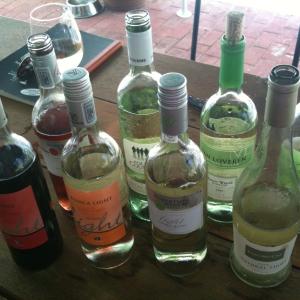New Year, new you. Well, that’s the message currently being drummed into me by DSTV so, as always, I am back on a ferocious diet. The biggest struggle for me in all this is the drinking. According to registered dietitian, Lee-Anne McHarry (leeanne.mcharry@gmail.com), a glass of wine contains anything between 350 and 500 kilojoules. When you consider that dietitians have bizarre opinions about portion sizes and that this is the energy found in a measly, tiny 120ml glass of wine, then for most of us, this spells trouble.
The energy or kilojoules in wine come from two different sources – the alcohol, and the residual sugar left in the wine after fermentation. Both will pile on the kilos which is why most dietitians try to get you to give up alcohol altogether if possible, and if not, then to only have 1 small glass per day with 2 days in the week completely alcohol-free. An off-dry or semi-sweet wine contains more kilojoules than a dry one and a heavy, alcoholic red contains more than a light-bodied one. When I realised that I can easily consume the equivalent of 2 meals at a sitting and still end up sober and hungry, I started wondering about the alternatives.
So in an effort to increase my allowance, I thought I would try light wines instead – after all, it says on the labels ‘Low in kilojoules, low in alcohol’ – so surely I could drink more? Alas, not so according to Lee-Anne. “The guideline is still one glass a day and – in the same way that 2 diet cookies seem somehow better than one normal one – the problem with light wine is convincing people that more light wine will not result in less of you. However, if you can stick to the allowance of one small glass a day, then yes, it is indeed a better choice than a full-strength wine.” So, with hope in my heart and a few other perpetual dieters in tow, I tackled some of the most popular and best-selling light wines to see how they measured up.
Light wine has quite a negative reputation – the words ‘watery’, ‘acidic’ and ‘tasteless’ were all bandied round freely amongst my fellow-tasters before we started, and I have to say that I was fairly sceptical about whether there would be enough depth of flavour to make them worthwhile. The alcohol levels were all fairly low – between 9 and 9.5% – but the residual sugar varied between 2g and a whopping 24.8g per litre which certainly makes the claim to be low in kilojoules seem fairly dubious in my opinion! I would have liked to have seen the amount of kilojoules on the labels but sadly, apart from claiming to be lower, none of them said exactly by how much, which is a pity in this information-packed age.
We tried 10 different wines and then (I am sorry to say) we completely exceeded our daily guidelines and polished off 5 of the bottles! These were our favourites:
Robertson Winery Extra Light Sauvignon Blanc 2009 (Alcohol 9.5%, residual sugar 4.5g)
Quite tart and short, but pleasant lemony, citrussy flavours with hazelnut hints. Peter’s favourite, and we finished the bottle.
Woolworths Light Chenin Blanc 2009 (Alcohol 9%, residual sugar 6g)
‘Fine for people used to drinking box-wine by the pool – so I’ll stock up!’ was Craig’s comment! Attractive Chenin flavours of crunchy apples and pears. We finished the bottle.
Van Loveren Light White Semillon 2009 (Alcohol 9%, residual sugar 2g)
Drinkable quaffer with green grassy notes, biting acidity and short, zingy finish. Finished the second bottle – first one was corked. Probably the lowest in kilojoules of the wines we tasted.
Fleur du Cap Natural Light 2009 (Alcohol 9.5%, residual sugar 9.6g)
‘Finally a nice aroma, but what a naff-shaped bottle!’ said Annelize. Concentrated palate (yes, really!) with grapefruits and soft, perfumed, floral notes. Finished the bottle.
Robertson Winery Light Pinotage Rosé 2009 (Alcohol 9.7%, residual sugar 24.8g)
Sweet rose petal nose and a pleasing richness after quite a few tart, acidic numbers. Craig’s favourite, but possibly only an improvement kilojoules-wise for people who normally drink semi-sweet wines.
Woolworths Light Shiraz 2009 (Alcohol 9%, residual sugar 11g)
The only red in the line-up. Genuine Shiraz flavours and aromas with a pleasing smokiness and a good firm finish. Really rather good and we finished the bottle with alacrity.
Do you have any tips for drinking and dieting? All advice welcomed!

